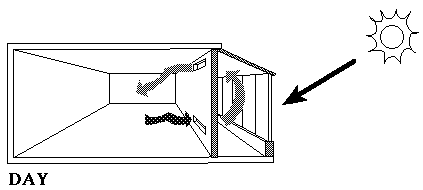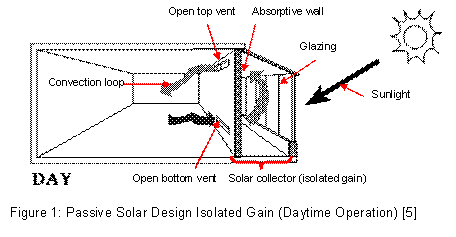Design team members: Edward Pang and Lin Cui
Supervisor: Professor P. Fieguth
Background
Current non-renewable energy usage in Ontario exceeds 140,000 GWh per year, and of that 33% is the result of residential electricity consumption, of which 23.3% represents demand for space heating. [1] Therefore, the total electricity used for residential space heating in Ontario averages to about 10,765 GWh per year. Given that the total number of households in Ontario amounts to approximately 4.39 million, according to Statistics Canada 2003, it is plausible that the average Ontario household uses about 2.45 MWh of non-renewable energy toward space heating each year.
[2] "Solar energy is a renewable resource limited only by the inflow rate from the sun to the earth."[3] The solar energy reaching the earth's surface on a clear day averages to about 950W/m2. [4] Therefore, our team endeavours to capitalize on this free energy source to facilitate household space heating by designing a Passive Solar Hybrid Convection System - an isolated gain, air-based passive solar heating system coupled with the conventional furnace. Figure 1 illustrates the fundamental principles involved with isolated gain, air-based passive solar design.

Project description
Problem statement:
"Design a Passive Solar Hybrid Convection System, to be used in new homes, for energy efficient household heating, which will be achieved through the integration of a passive solar collector, forced air distribution, a digital user interface, and a control system." Figure 2 illustrates the general interactions between the system components.

Concept:
Our proposed project involves designing and analyzing several components to facilitate passive solar heating. These components include, the Passive Solar Collector, the user interface, the motor actuated vents, the forced air fans, and the control system, which controls the components based on user inputs, sensor information and sound logic. Heating will be achieved through the forced convection of air, no different from the distribution network used by the typical household central heating system.
The purpose of Passive Solar Hybrid Convection System is to capture solar energy, and provide a means to actively distribute the thermal energy into a home when space heating is desired. The Passive Solar Collector functions as the primary heat source, while the furnace functions as an auxiliary source. The user will have the ability to input a desired temperature, and the system will respond by diverting the warm air from the Passive Solar Collector to the home. Depending on the availability of solar energy at the time of user input, the system will vary the forced air fan speed and also decide whether or not to activate the furnace. As a result, the overall energy use for heating a home will be optimized by this hybrid technology.
Design methodology
1) Perform literature review to understand and define the problem by identifying criteria and constraints [100%]
- research passive solar design, central household heating, sun angles, and solar gain
- research thermodynamics involved with passive solar design, and heat transfer
- research microcontroller design and programming
2) Design and construct functional prototype of a Passive Solar Collector [100%]
- Use simulations to model the thermodynamic behaviour of the Passive Solar Collector
- Perform extensive testing on Passive Solar Collector to provide substantiation to prove the concept
- Use testing and analysis results to justify control system component requirements
3) Design and implement functional prototype of control system and user interface using Basic Stamp 2pe, temperature sensors, LCD display, LEDs, and pushbuttons [75%]
4) Design and build functional prototype of mechanical component: fans and motor actuated vents [0%]
5) Integrate the mechanical components with the control system by replacing LED indicators with functional mechanical components. Test, debug and evaluate the overall design. [0%]
References
[1] Ontario Power Authority. Electricity Demand in Ontario - A Retrospective Analysis. November 25, 2006. (PDF)
[2] Ontario Economic Development. Market Demographics: Total Ontario Households. August 2005.
[3] The Wilderness Publications, www.copvcia.com. © Copyright 2004. All rights reserved.
[4] Y. A. Cengel. Introduction to Thermodynamics and Heat Transfer. New York: McGraw-Hill, 1997.
[5] Green Builder. Passive Solar Guidelines. August 4, 2006.